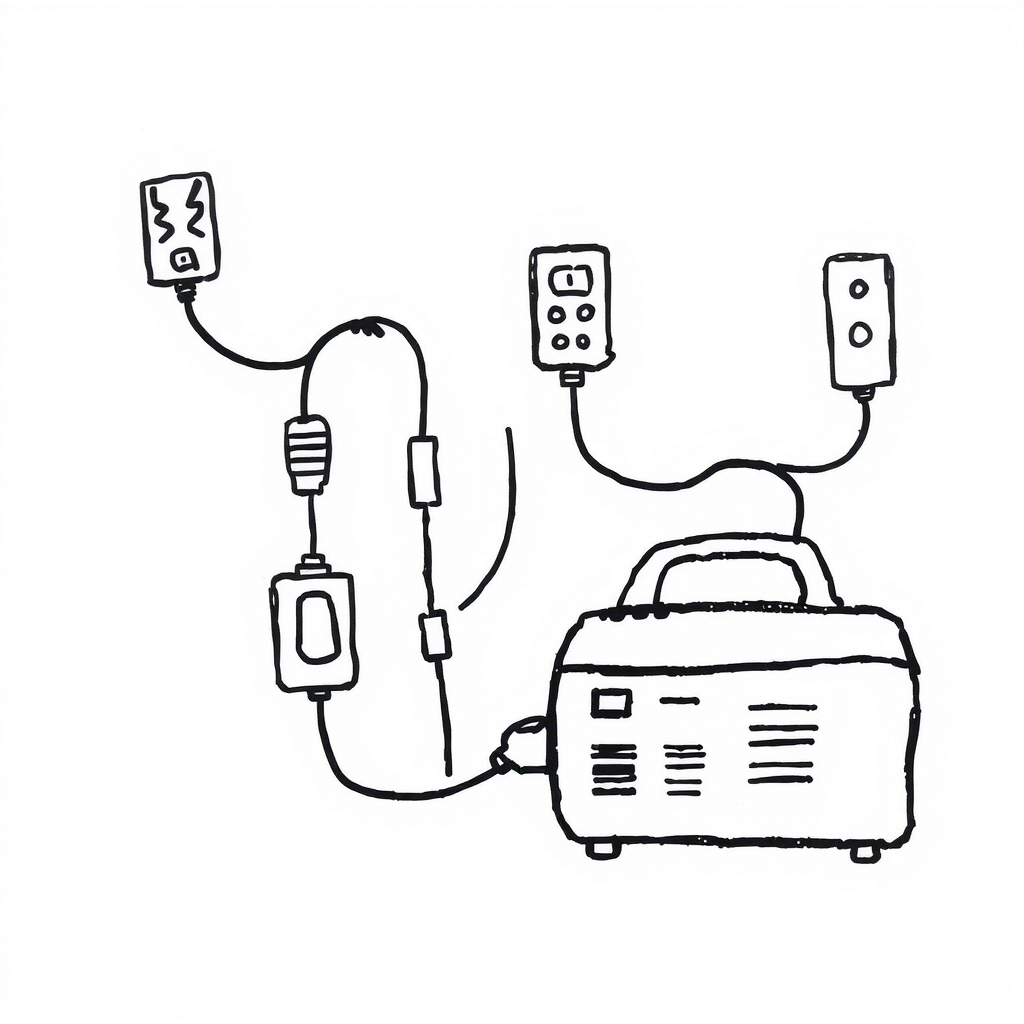Can I Make My Own Generator Transfer Switch?
As a homeowner, I’ve always been interested in being self-sufficient and prepared. So, the idea of making my own generator transfer switch intrigued me. But the more I looked into it, I realized it’s not as simple as it seems.
There’s technical knowledge, regulations, and specialized tools to consider. Improper installation and non-compliance with codes can be risky. After thorough research, I now understand the importance of professional installation.
In this article, I’ll explore the complexities and risks of DIY transfer switches and the availability of commercially made ones.
Key Takeaways
- Building a transfer switch requires technical knowledge, specialized tools, and compliance with regulations.
- It is generally recommended to purchase a commercially available transfer switch and have it professionally installed.
- Commercially available transfer switches are reliable, meet industry standards, and come with warranties.
- Seeking professional advice ensures compatibility, proper break-in process, and optimal generator selection.
The Complexity of Building Your Own Transfer Switch
Typically, building your own transfer switch can be quite complex and time-consuming. It requires building from scratch and a level of electrical expertise that not everyone possesses. Understanding wiring diagrams and complying with building codes and regulations are crucial aspects of the process. Non-compliance can result in fines and safety hazards, making it essential to have the necessary technical knowledge.
Additionally, specialized tools and equipment are required, making the task even more challenging. Even with the right expertise and tools, the time-consuming nature of building a transfer switch can lead to an unreliable final product. Moreover, working with electrical systems without experience can pose safety risks.
Considering these factors, it’s generally recommended to purchase a commercially available transfer switch and have it installed by a licensed electrician for a safer and more reliable solution.
Risks and Safety Hazards Involved in DIY Transfer Switches
I personally believe that it’s important to be aware of the numerous risks and safety hazards that are involved in DIY transfer switches.
While building your own transfer switch may seem like a cost-effective solution, it can pose serious safety risks if not done correctly. Without proper electrical expertise, there’s a higher chance of making mistakes that could result in electrical accidents or damage to your generator. Safety precautions, such as ensuring proper grounding and insulation, may be overlooked, putting you and your household at risk.
Additionally, building a transfer switch without compliance with building codes and regulations can lead to fines and safety hazards. It’s always recommended to seek the help of a licensed electrician who’s the necessary knowledge and experience to handle electrical systems safely.
Tools and Equipment Required for Making a Transfer Switch
To make a transfer switch, you’ll need a variety of tools and equipment to ensure a safe and successful installation. Here are the required tools for making a transfer switch:
- Wire strippers: These will be essential for removing the insulation from the wires to make proper connections.
- Screwdrivers: You’ll need both flathead and Phillips head screwdrivers to tighten screws and secure electrical components.
- Wire cutters: These will help you cut wires to the correct length and remove any excess.
- Voltage tester: This tool is crucial for checking if there’s any electrical current present before working on the switch.
The potential cost of these tools can vary depending on the quality and brand. However, investing in good quality tools is important for safety and long-term use.
Time Constraints and Reliability Issues With DIY Transfer Switches
Building a DIY transfer switch can be time-consuming and may result in unreliable performance. When attempting to make your own transfer switch, it’s important to consider the time constraints and reliability concerns that may arise.
Building a transfer switch requires technical knowledge, specialized tools, and compliance with regulations. Without proper experience and understanding of electrical systems, there’s a higher risk of errors or malfunctions in the final product. Additionally, the time required to research, gather materials, and assemble the transfer switch can be significant. If mistakes are made, it may take even more time to troubleshoot and fix any issues that arise.
In contrast, purchasing a commercially available transfer switch ensures reliability, as these products are designed and tested for performance. It’s advisable to prioritize reliability and seek professional help for the installation of a transfer switch.
Non-Compliance With Building Codes and Regulations
Failing to comply with building codes and regulations can result in fines and pose safety hazards. It’s essential to prioritize building code compliance and adhere to safety regulations when installing a generator transfer switch. Here are four reasons why non-compliance should be avoided:
- Safety risks: Building codes and regulations are in place to ensure the safe installation and operation of electrical systems. Non-compliant transfer switches may not provide proper grounding or protection against electrical faults, increasing the risk of electrical accidents and fires.
- Legal consequences: Non-compliance with building codes can lead to significant fines and penalties. Building inspectors may require corrections or even shut down the installation until it meets the required standards.
- Insurance concerns: Insurance companies may deny claims for damages caused by non-compliant transfer switches. In the event of an accident or fire, lack of compliance could leave homeowners financially responsible.
- Resale value: Non-compliant electrical installations can negatively impact the resale value of a home. Prospective buyers may hesitate to purchase a property with safety concerns or require costly repairs before finalizing the sale.
To ensure safety, avoid penalties, and protect your investment, it’s always recommended to consult with a licensed electrician and ensure compliance with building codes and regulations.
Benefits of Professional Installation for Transfer Switches
Professional installation offers peace of mind and ensures the correct and safe installation of a transfer switch.
While there may be benefits to making your own transfer switch, such as potentially saving money on installation costs, it’s important to consider the risks and complexities involved.
Building a transfer switch requires technical knowledge, specialized tools, and compliance with regulations. Non-compliance can lead to fines and safety hazards.
On the other hand, professional installation by licensed electricians ensures that the transfer switch is installed correctly, reducing the risk of electrical accidents or damage to the generator. Additionally, electricians can ensure compliance with building codes and regulations, providing peace of mind and reliable performance.
When considering the cost comparison of DIY versus professional installation, the potential risks and time-consuming nature of DIY installation may outweigh the savings.
Availability and Reliability of Commercially Available Transfer Switches
I can easily find commercially available transfer switches at various retailers both in-store and online. Here are some reasons why these commercially available transfer switches are a reliable and convenient option:
- Cost effectiveness: Commercially available transfer switches come in a range of prices, making it easier to find one that fits your budget.
- Variety of options: There are different types of transfer switches available, including manual, automatic, and combination switches. This allows you to choose the one that best suits your needs and preferences.
- Reliability: These transfer switches are designed and tested for reliability, ensuring that they’ll function properly during power outages. They also come with warranties and customer support, providing peace of mind.
- Ease of installation: Commercially available transfer switches are designed to be user-friendly and can be installed by a licensed electrician. This eliminates the need for complex wiring and ensures a safe and efficient installation process.
Importance of Seeking Professional Advice for Transfer Switches
Seeking professional advice is crucial when it comes to ensuring the safe and efficient operation of transfer switches.
It’s important to consult with professionals for compatibility considerations and optimal generator selection.
Professionals have the knowledge and expertise to guide you in selecting the right transfer switch that’s compatible with your home’s electrical system and the generator you plan to use.
They can provide valuable insights on the electrical requirements and ensure that the transfer switch is properly installed.
Additionally, professionals can recommend the best generators based on your individual needs, ensuring that you have a reliable power source during emergencies.
Conclusion
After thorough research and consideration, I’ve come to the conclusion that making your own generator transfer switch isn’t a feasible or safe option. The complexity, risks, and compliance issues involved make it crucial to seek professional installation and advice.
Commercially available transfer switches provide the necessary reliability and compliance with building codes. It’s important to prioritize safety and ensure that your home’s electrical system is properly connected to a generator through a professionally installed transfer switch.


